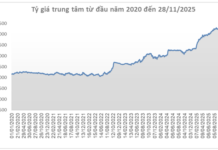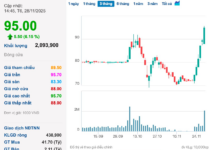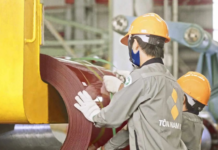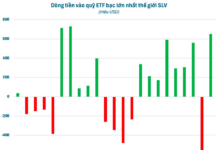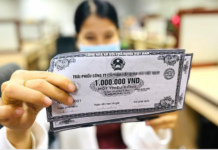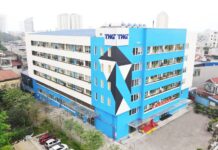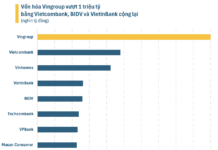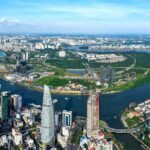Can’t leave, can’t stay
The observation from PV Tien Phong at the investment area for the project under the Hanoi National University at Hoa Lac shows that, despite many years of handover, the roads and technical infrastructure of this area are still incomplete. Some residents of Thon 5 (Thach Hoa commune, Thach That district) said that they have requested the completion of the infrastructure in the investment area to stabilize their lives, but nothing has been implemented so far.
Mr. Dong (Thon 5) said that currently, people have to buy expensive electricity through the project management board. Clean water is not available, and the well water does not meet quality requirements. “Because of that, many households have chosen to stay at their old places,” Mr. Dong said.
According to the investigation by PV, the construction of the investment area is carried out by the People’s Committee of Thach That district as the investor since 2007. Currently, there are more than 200 households assigned the investment area, 9 households have built houses in this area, but due to the lack of electricity and water, many households still live in the project and have not handed over the land, although they have been allocated the investment land. Currently, about 100 households still have complications related to the investment area regime. The Investment Construction Management Board of the Hanoi National University project in Hoa Lac has sent many documents to the People’s Committee of Thach That district, requesting to expedite the progress of reviewing the investment area for households, but there has been no significant progress so far.

Some component projects in the Hanoi National University at Hoa Lac are being implemented
The Hanoi National University project is located on the land of Thach That district, about 30km west of the center of Hanoi. In 2002, the Government approved the investment project to build the Hanoi National University at Hoa Lac with the main goal of building the most advanced and modern university urban area in Southeast Asia. With an area of over 11.13km2, the Hanoi National University is the largest university in Vietnam.
However, for various reasons, the project is behind schedule and 20 years later (in 2022), only 2,000 new students were transferred here to study. In 2023, there will be 6,000 students studying. It is expected that by 2025, there will be 15,000 students studying. According to the plan, the Hanoi National University will meet the learning needs of 60,000 students.
Special mechanisms are needed to remove obstacles for the project
According to the statistics from the People’s Committee of Thach That district, by the end of January 2024, the Hanoi National University project and the component projects implemented in Thach Hoa and Tien Xuan communes have cleared about 1,001.3 / 1,218.1ha of land of all types (achieving 82%), with over 216.8ha of land not yet cleared (GPMB). Among the remaining uncleared area, the Hanoi National University project still has more than 109ha.
The biggest obstacle affecting the progress of land clearance is verifying the origin of the land of households under the clearance process, leading to the situation that some households do not meet the conditions for handing over land for investment. In cases where the investment area is approved, there is also a discrepancy in the initial and final compensation prices, resulting in households not agreeing to receive compensation and support money.
Recently, the Hanoi Department of Natural Resources and Environment issued a written reply to the People’s Committee of Thach That district on resolving problems in the land clearance work of the Hanoi National University project in Hoa Lac. Accordingly, for cases where there is only a decision to allocate land, a land allocation minutes without a name on the land allocation list prepared by Agricultural Field 1A in June 2001, the People’s Committee of Thach That district reviewed the special policies approved by the Prime Minister for the project to implement compensation and support resettlement as prescribed.
To resolve these issues, in recent times, the People’s Committee of Thach That district has reported to the People’s Committee of Hanoi city and the Hanoi Department of Natural Resources and Environment to request guidance.
According to the Investment Management Board, by the end of 2023, the disbursement rate of the project will reach 28.3 billion VND out of 98.3 billion VND, equivalent to 24% of the estimated total. The delay in disbursement of the land clearance funds is due to the slow progress of compensation, verification, and payment to households as there is no focus on priority areas. The period from verification to when households receive payment takes 3-4 months, affecting the progress of project implementation.
The Investment Management Board recommends that the Chairman of the People’s Committee of Hanoi city directly instruct the land clearance work of the project according to the directions of the Government, to solve the following contents: Resolve the recommendations of the People’s Committee of Thach That district on some proposals, related recommendations regarding mechanisms and policies in the land clearance work to serve implementation.
Regarding the recovery of land for households that have received the full compensation regime and households that have encroached on the land, the Investment Management Board proposes that relevant agencies inspect and review the recovery of these areas to prevent the situation of encroachment, causing the waste of state assets and difficulties in clearing the area for project implementation.









